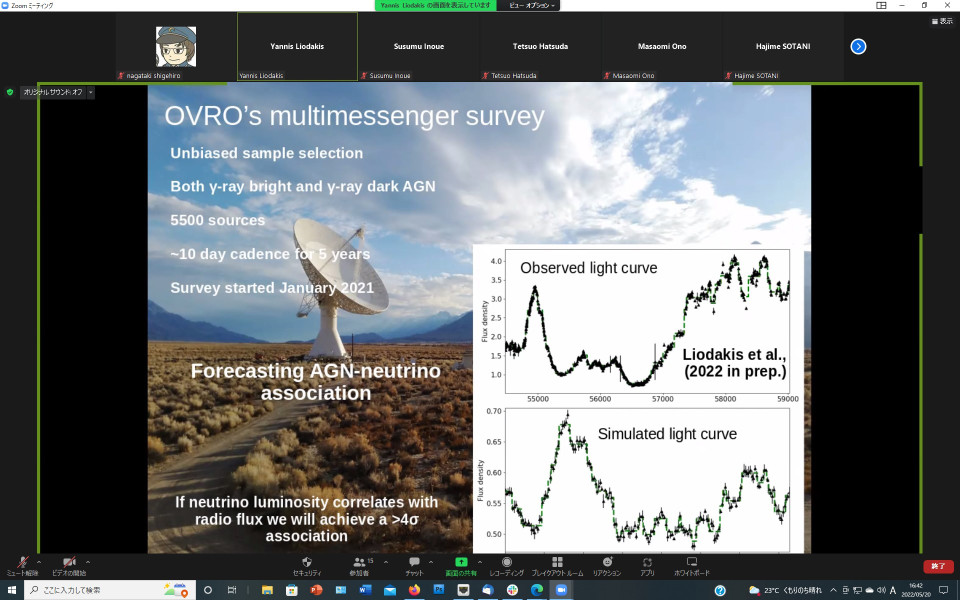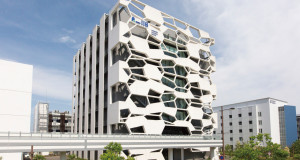Volume 200
Back to Newsletter List
Seminar Report
ABBL-iTHEMS Joint Astro Seminar by Dr. Yannis Liodakis on May 20, 2022
2022-05-23
The origin of high-energy neutrinos is fundamental to our understanding of the Universe. Apart from the technical challenges of operating detectors deep below ice, oceans, and lakes, the phenomenological challenges are even greater. The sources are unknown, unpredictable, and we lack clear signatures. Neutrino astronomy therefore represents the greatest challenge faced by the astronomy and physics communities thus far. The possible neutrino sources range from accretion disks and tidal disruption events, through relativistic jets to galaxy clusters with blazar TXS 0506+056 the most compelling association thus far. Since then, immense effort has been put into associating AGN-jets with high-energy neutrinos, but to no avail. The speaker discussed his current efforts in understanding the multimessenger processes in the Universe, and once and for all proving or disproving if AGN-jets are neutrino emitters.
Reported by Shigehiro Nagataki
The Hunt for Extraterrestrial Neutrino Counterparts
May 20 (Fri) 16:00 - 17:00, 2022
Upcoming Events
Seminar
iTHEMS Biology Seminar
Do the mechanisms of speciation vary with latitude? Empirical case study 1: evolution of the plant cycad genus Ceratozamia from Mexico
June 2 (Thu) 16:00 - 17:00, 2022
José Said Gutiérrez-Ortega (Special Postdoctoral Researcher, RIKEN Interdisciplinary Theoretical and Mathematical Sciences Program (iTHEMS))
“Species” form biodiversity, and “speciation” is the evolutionary process that originate them. Speciation can occur by stochastic processes —neutral theory— or through the influence of ecological factors —selection theory—. They are not competing theories, but rather explain different facets of speciation. But the mechanisms of speciation seem quite to depend on the group of study and its underlying spatial and temporal factors. Why do in some groups species are more prone to evolve via selection or stochastically than others? It does not exist a unified theory that can explain and predict events of speciation at the global level. However, I hypothesize that there is a latitude-association between two main mechanisms of speciation: 1) “allopatric speciation by means of niche conservatism” and 2) “ecological speciation by means of niche divergence”. The first is hypothetically more common at low latitudes, and the second is more common at high latitudes. In this context, I will use the recent results of my own empirical research on the plant cycad genus Ceratozamia from Mexico as an example to show how mechanisms of speciation seem to covariate with latitude. Hopefully, you can help me to formulate a theory that can explain where and under what factors speciation can occur.
Venue: via Zoom
Event Official Language: English
Seminar
ABBL-iTHEMS Joint Astro Seminar
Core-collapse Supernova Models with Heavy Axion-like Particles
June 3 (Fri) 14:00 - 15:00, 2022
Kanji Mori (Research Institute of Stellar Explosive Phenomena (REISEP), Fukuoka University)
Axion-like particles (ALPs) are a class of hypothetical bosons which feebly interact with ordinary matter. The hot plasma of stars and core-collapse supernovae is a possible laboratory to explore physics beyond the standard model including ALPs. Once produced in a supernova, some of the ALPs can be absorbed by the supernova matter and affect energy transfer. We recently calculated the ALP emission in core-collapse supernovae and the backreaction on supernova dynamics consistently. It is found that the stalled bounce shock can be revived if the coupling between ALPs and photons is as high as $g_{a\gamma}\sim 10^{-9}$ GeV$^{-1}$ and the ALP mass is 40-400 MeV.
Venue: via Zoom
Event Official Language: English
Seminar
DMWG Seminar
Cosmological phenomena with sterile neutrino
June 6 (Mon) 16:30 - 18:00, 2022
Shintaro Eijima (Institute for Cosmic Ray Research (ICRR), The University of Tokyo)
Event Official Language: English
Seminar
NEW WG Seminar
Non-Abelian vortices in two-flavor dense QCD
June 15 (Wed) 13:30 - 15:00, 2022
Yuki Fujimoto (Postdoctoral Scholars, Department of Physics, University of Washington, USA)
Recently, the phase of the two-flavor quark matter with the new
pattern of color superconductivity was proposed so that the continuous
crossover from the hadronic to the quark phase is realized [1]; it is
in consonance with the recent observation of neutron stars.
In this talk, I will show the classification of the topological
vortices in this phase. We found that the stable vortices are what we
call the "non-Abelian Alice strings" [2]. They are superfluid
vortices carrying 1/3 quantized circulation and color magnetic fluxes.
I will discuss their properties in comparison to the well-established
CFL vortices in three-flavor symmetric setup, by putting some emphasis
on their peculiarity: the non-Abelian generalization of the Alice
property. I will then discuss in detail the possibility that these
vortices are confined as well as how the vortices in the quark phase
can be connected to those in the hadronic phase [3].
[1] Y. Fujimoto, K. Fukushima, W. Weise, PRD 101, 094009 (2020) [1908.09360].
[2] Y. Fujimoto, M. Nitta, PRD 103, 054002 (2021) [2011.09947]; JHEP 09 (2021) 192 [2103.15185].
[3] Y. Fujimoto, M. Nitta, PRD 103, 114003 (2021) [2102.12928].
Venue: via Zoom
Event Official Language: English
Seminar
iTHEMS Theoretical Physics Seminar
Dress code for infrared safe S-matrix in QED
June 22 (Wed) 13:30 - 15:00, 2022
Sotaro Sugishita (Designated Assistant Professor, Institute for Advanced Research (IAR), Nagoya University)
We consider the infrared (IR) aspects of the gauge invariant S-matrix in QED. I will review the problem of IR divergences in QED, and introduce the dressed state formalism to obtain IR-safe S-matrix elements. I will show a condition for dressed states to obtain IR-safe S-matrix elements, and explain that this condition can be interpreted as the memory effect and is related to asymptotic symmetry. I also explain that IR divergences are necessary to prohibit the violation of asymptotic symmetry. We also argue that the difference between dressed and undressed states can be observed, even if we are able to observe an inclusive cross-section summing over soft photons.
Venue: Hybrid Format (Common Room 246-248 and Zoom)
Event Official Language: English
Seminar
NEW WG Seminar
Superconducting-like heat current: Effective cancellation of current-dissipation trade-off by quantum coherence
July 25 (Mon) 13:30 - 15:00, 2022
Tajima Hiroyasu (Assistant Professor, Graduate School of Informatics and Engineering, The University of Electro-Communications)
Recent developments in statistical mechanics have revealed a tradeoff between heat current and dissipation [1,2]. In various situations, this current-dissipation tradeoff represents a relationship between thermal energy flow and entropy increase, similar to Joule’s law W=RI^2.
On the other hand, the coherence effect on the current-dissipation tradeoff has not been thoroughly analyzed. Here, we systematically analyze how coherence affects the current-dissipation tradeoff [3]. The results can be summarized in the following three rules:
- Quantum coherence between different energy levels strengthens the trade-off. In other words, the ratio between the square of the heat current and the entropy production ratio corresponding to electrical resistance R (hereafter referred to as "thermal resistance") is increased by the superposition of different energy levels.
- Coherence between degeneracies weakens the trade-off. That is, thermal resistance is weakened by coherence between degeneracies.
- With enough coherence between degeneracies, we can cancel the trade-off effectively and make the thermal resistance approximately zero. Then, macroscopic heat flow without entropy increase is realized.
These three results directly reveal the coherence effects on heat engine performance. That is, coherence between different energy levels reduces the performance, while coherence between degeneracies increases it. And when there is a sufficient amount of coherence between degeneracies, the efficiency can asymptotically reach the Carnot efficiency (η=η_{Car}-O(1/N)) while the power is O(N).
References
- N. Shiraishi, K. Saito, H. Tasaki, Universal Trade-Off Relation between Power and Efficiency for Heat Engines, Phys. Rev. Lett. 117, 190601 (2016), doi: 10.1103/PhysRevLett.117.190601
- A. C. Barato, U. Seifert, Thermodynamic Uncertainty Relation for Biomolecular Processes, Phys. Rev. Lett. 114, 158101 (2015), doi: 10.1103/PhysRevLett.114.158101
- H. Tajima, K. Funo, Superconducting-like Heat Current: Effective Cancellation of Current-Dissipation Trade-Off by Quantum Coherence, Phys. Rev. Lett. 127, 190604 (2021), doi: 10.1103/PhysRevLett.127.190604
Venue: via Zoom
Event Official Language: English
Workshop
DM3 - Deep insights and Multiple strategies for Deciphering the Mystery of Dark Matter
September 15 (Thu) - 17 (Sat) 2022
Venue: SUURI-COOL (Kobe), Room S704-S705, Integrated Innovation Building (IIB), Kobe Campus, RIKEN / via Zoom
Event Official Language: English
Paper of the Week
Week 5, May 2022
2022-05-26
Title: Reheating after relaxation of large cosmological constant
Author: Paul Martens, Shinji Mukohyama, Ryo Namba
arXiv: http://arxiv.org/abs/2205.11754v1
Title: Accuracy of one-dimensional approximation in neutron star quasi-normal modes
Author: Hajime Sotani
arXiv: http://arxiv.org/abs/2205.10523v1
Title: Attractive $N$-$φ$ Interaction and Two-Pion Tail from Lattice QCD near Physical Point
Author: Yan Lyu, Takumi Doi, Tetsuo Hatsuda, Yoichi Ikeda, Jie Meng, Kenji Sasaki, Takuya Sugiura
arXiv: http://arxiv.org/abs/2205.10544v1
If you would like to cancel your subscription or change your email address,
please let us know via our contact form.
Copyright © iTHEMS, RIKEN. All rights reserved.





